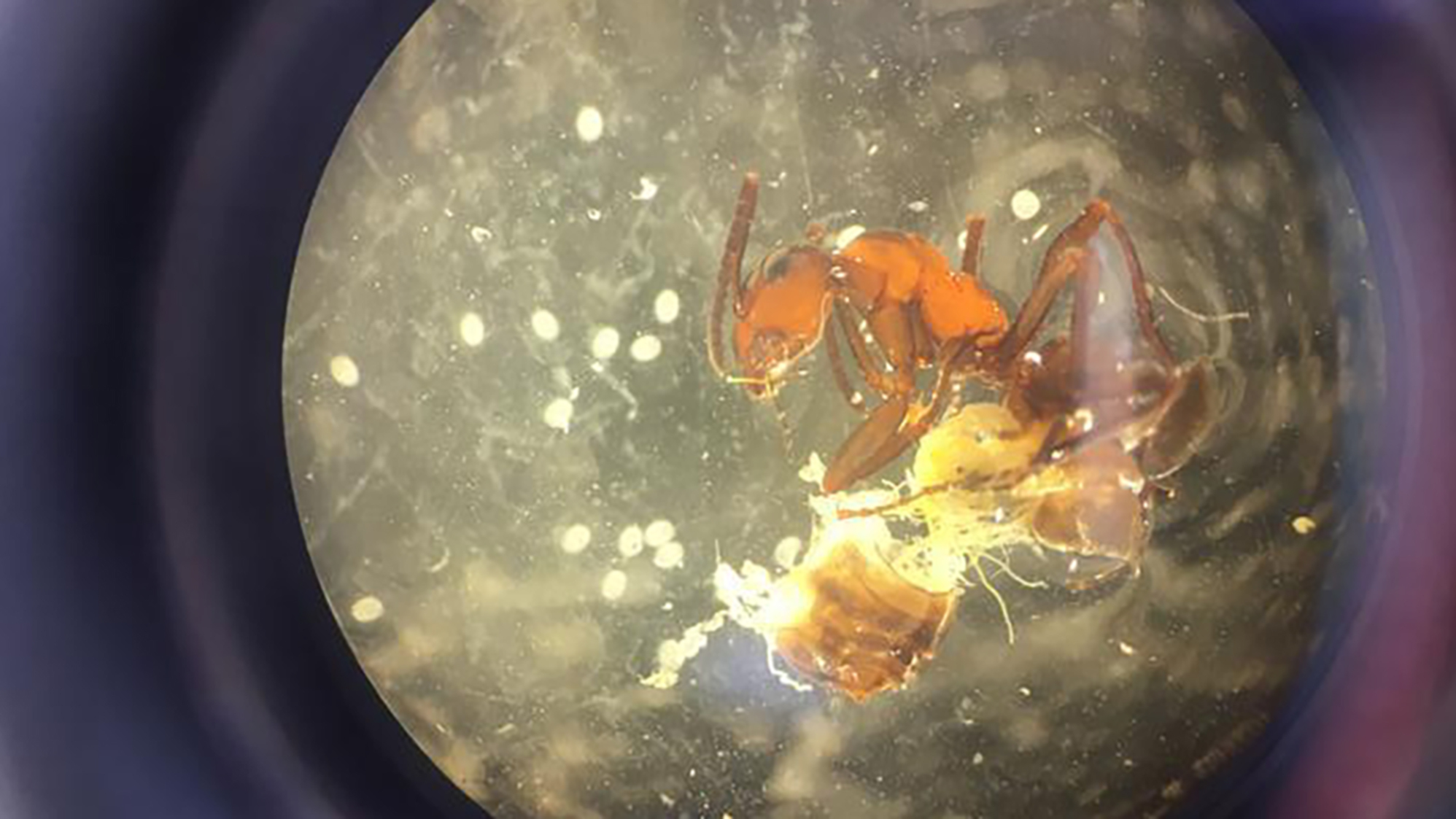

Just in time for spooky season, scientists have learned more about how a tiny parasitic flatworm called the lancet liver fluke infects and controls the brains of ants. With their complex four-step cycle, the flukes could be cunningly adjusting to daily changes in air temperatures to infect more hosts. The findings were recently published in the journal Behavioral Ecology.
[Related: Mind-controlling ‘zombie’ parasites are real.]
Step 1: The Zombie Ant
The parasite hijacks an ant’s brain after an ant eats a ball of snail mucus infested with fluke larvae. The larvae then mature inside the brain, where the parasite can make the ant climb up a blade of grass and clamp down on the blade. This strategic height makes it easier for the parasite’s next potential host—a cow, sheep, deer, or other grazer—to eat the flukes and offer it another place to live and breed. This new study found that the liver fluke can even get the ant to crawl back down the blade of grass when it gets too hot.
“Getting the ants high up in the grass for when cattle or deer graze during the cool morning and evening hours, and then down again to avoid the sun’s deadly rays, is quite smart. Our discovery reveals a parasite that is more sophisticated than we originally believed it to be,” University of Copenhagen biologist and study co-author Brian Lund Fredensborg said in a statement. Fredensborg conducted the research with his former graduate student Simone Nordstrand Gasque, now a PhD student at Wageningen University in the Netherlands.
In their study, the team tagged several hundred infected ants in the Bidstrup Forests near Roskilde, Denmark. “It took some dexterity to glue colors and numbers onto the rear segments of the ants, but it allowed us to keep track of them for longer periods of time,” said Fredensborg.
The team observed how the infected ants behaved to humidity, light, time of day, and temperature and it was clear that temperature has an effect on their behavior. During cooler temperatures, the ants were more likely to be attached to the top of a blade of grass. When the temperature rose, the ants let go of the grass and crawled back down.
“We found a clear correlation between temperature and ant behavior,” said Fredensborg. “We joked about having found the ants’ zombie switch,’”
Step 2: The Grazer
Once the liver fluke infects the ant, several hundred parasites invade the insect’s body. Only one of these parasites will make it to the brain where it then influences the ant’s behavior. The remaining liver flukes conceal themselves in the ant’s abdomen inside of its intestine. There, the liver flukes find their way through the bile ducts and into the liver, where they suck blood and develop into adult flukes that begin to lay eggs.
[Related: ‘Brainwashing’ parasites inherit a strange genetic gap.]
“Here, there can be hundreds of liver flukes waiting for the ant to get them into their next host. They are wrapped in a capsule which protects them from the consequent host’s stomach acid, while the liver fluke that took control of the ant, dies. You could say that it sacrifices itself for the others,” said Fredensborg.
The eggs are then excreted in the host animal’s feces.
Step 3: The Snail
Once the fluke eggs have been excreted, they remain on the ground waiting for a snail to crawl by and eat the feces. When the eggs are inside the snail, the eggs develop into larval flukes that reproduce asexually and can multiply into several thousand.
“Historically, parasites have never really been focused on that much, despite there being scientific sources which say that parasitism is the most widespread life form,” said Fredensborg. “This is in part due to the fact that parasites are quite difficult to study.”
Step 4: The Slime Ball
To exit the snail and move on to their next host, the larval flukes make the snail cough. The flukes are then expelled from the snail in a lump of mucus. The ants are attracted to this moist ball, eat it, and unwittingly ingest more fluke larvae and the cycle begins all over again.
The tiny liver fluke is widespread in Denmark and other temperate regions around the world and researchers are still trying to understand more of the mechanisms behind how they take over a host’s brain.
“We now know that temperature determines when the parasite will take over an ant’s brain. But we still need to figure out which cocktail of chemical substances the parasite uses to turn ants into zombies,” Fredensborg said. “Nevertheless, the hidden world of parasites forms a significant part of biodiversity, and by changing the host’s behavior, they can help determine who eats what in nature. That’s why they’re important for us to understand.”
